San Francisco Letter No. 24
San Francisco Ballet
Program 4
“Spring Rounds,” “Chi-Lin,” “Eden/Eden”
March 14, 2006
Program 5
“Pacific,” “Carousel (A Dance),” “The Fifth Season,” “Fancy Free”
March 16, 2006
by Rita Felciano
copyright ©2007, Rita Felciano
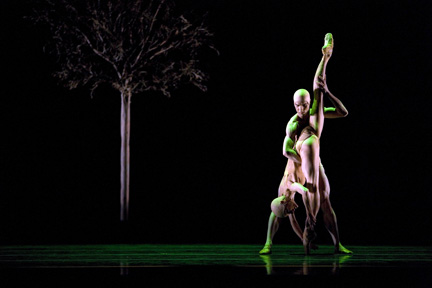 It’s fascinating to see how in ballet the triumvirate of music, choreography and performance feed each other. Though inextricably interwoven, these three “muses” rarely satisfy equally. When they do, the stage turns into heaven.
It’s fascinating to see how in ballet the triumvirate of music, choreography and performance feed each other. Though inextricably interwoven, these three “muses” rarely satisfy equally. When they do, the stage turns into heaven.
None of the pieces in San Francisco Ballet's Program 4’s triple bill were first-rate yet each had a special sheen. It was one of those evenings that you were grateful for the excellence of these dancers; it may not be enough to make ballet-going a must, but enough to keep you going.
The American premiere of Wayne McGregor’s nine-dancer “Eden/Eden” had teeth, edge and drama. Most of it came from ‘Dolly’, the third section of Steve Reich and Beryl Korot’s quasi-opera, which the choreographer used for this pale examination of the natural and the man-made world. Conducted by Gary Shelton, the small chamber group and four remarkable singers imposed their own considerable and much welcome force on the stage proceedings.
“Eden/Eden” — its title suggests several possibilities for mankind’s origins — purports to question the impact of technology on humankind. A Laurie Anderson-inspired sound track of debating scientists includes the consideration of technology as a continuation of evolution and the possibility of biologically upgrading one-self. In Ravi Deepres’ video, an astrology chart suggests an early attempt to interpret and control biology. The ideas are fascinating but their translation onto the stage is less so.
Where McGregor succeeds is in imagining the evolution of embryo-like beings into something approaching recognizable men and women through choreography that is angular, fragmented and aggressively physical. The dancers rise from below as if spewed out by a subterranean conveyor belt in feature-obliterating nude body stockings and caps (by Ursula Bombshell). Eventually, they don — dropped from heaven — minimal garments. In murky lighting (by Charles Balfour), they anonymously couple, contort each other’s limbs, and throw each other around. This is the body dissected at top speed into its constituent parts, presented in an uninflected, emotionally neutral tone. And that’s the response that “Eden/Eden” got from this particular viewer.
Muriel Maffre and Gonzalo Garcia were the First Couple; corps member Dana Genshaft, a dynamo of athletic energy, and Mascal Molat, a subsidiary one. The other heroic performers were Jaime Garcia Castilla, Hayley Farr, Rory Hohenstein, Moises Martin and Katita Waldo.
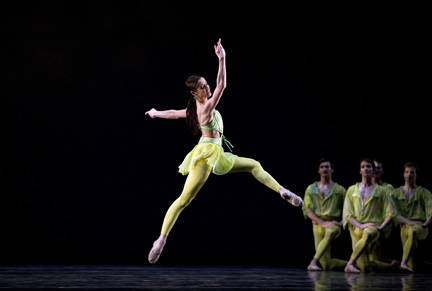 Paul Taylor’s SFB-commissioned “Spring Rounds” is one of those pieces that Taylor seems to turn out routinely between more significant efforts. Routine Taylor still is awfully good. There may not be many new ideas, but he uses familiar ones with such mastery.
Paul Taylor’s SFB-commissioned “Spring Rounds” is one of those pieces that Taylor seems to turn out routinely between more significant efforts. Routine Taylor still is awfully good. There may not be many new ideas, but he uses familiar ones with such mastery.
The choice by this ever so musical choreographer of Richard Strauss’ Divertimento for small orchestra, OP 86 (after Couperin) adds immense appeal to “Rounds”. Strauss rarely makes it onto the ballet stage. This is an effervescent work, in which individual instruments pop up like so many spring flowers. At one point, Couperin steps very much into the foreground, making sure that his and the voice of baroque music are acknowledged.
The ensemble sections—line-ups and circles of many types, including a pseudo polka--balance individualized small ensembles and solos ever so elegantly. In the cavortings of these young lovers/buddies/best friends formal bows and athletic cartwheels are as natural as arm-in-arm walks and sliding down a partner’s back. The frivolity of head-butting men against traipsing women may make you smile but the hands tenderly touching the earth remind you of your mortality.
Vanessa Zahorin, rather stiffly, and Garrett Anderson danced the central couple. Brooke Moore brought a lovely delicate touch to a small solo; Matthew Stewart an airy elegance to his flying leaps. Even though this was a less than polished performance, SFB’s dancers dove with gusto into Taylor’s cloud-busting celebration of everything young.
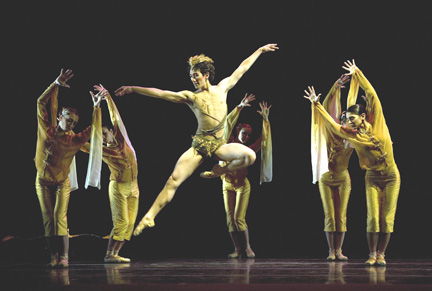 “Chi-Lin” was Helgi Tomasson’s 2002 gift for his Shanghai-born ballerina Yuan-Yuan Tan. Set to excerpts of several scores by Bright Sheng, Tomasson’s imagistic approach weighs the work down. He let himself be inspired by Chinese astrology in which a chi-lin (unicorn) represents earth, a dragon air, a tortoise water and a phoenix fire. Too much of the resulting scenario feels like ponderous exposition. Most bothersome are Tomasson’s rather crude attempts at chinoiserie.
“Chi-Lin” was Helgi Tomasson’s 2002 gift for his Shanghai-born ballerina Yuan-Yuan Tan. Set to excerpts of several scores by Bright Sheng, Tomasson’s imagistic approach weighs the work down. He let himself be inspired by Chinese astrology in which a chi-lin (unicorn) represents earth, a dragon air, a tortoise water and a phoenix fire. Too much of the resulting scenario feels like ponderous exposition. Most bothersome are Tomasson’s rather crude attempts at chinoiserie.
However, the piece received a mostly splendid performance with Pierre-Francois Vilanoba taking over another of Yuri Possokhov’s roles, that of the Dragon; Hansuke Yamamoto, who has graduated from a jumper into a dancer of promising complexity, danced the Phoenix. The only misstep was Tiit Helimets’ bland Tortoise. Helimets is a tall good-looking fellow with a beautiful technique, but he does not seem able to step outside his image of himself and into a role.
Tan was a marvel. Her exquisite phrasing, the attention to detailed gesture and the ability to project quick-silvery mood changes showed her in full command of her gifts. The joy and freedom of her dancing took your breath away.
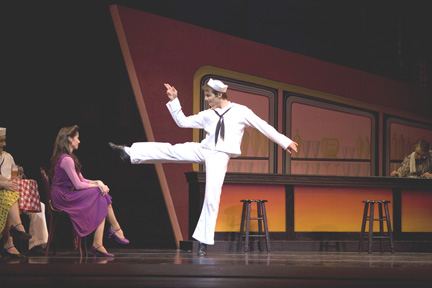 Program 5 was a good one for musical theater lovers. The compilation of material from Richard Rogers’ “Carousel” for Christopher Wheeldon’s tribute to the composer and Leonard Bernstein’s jaunty “Fancy Free” both had the unmistakable smell of Broadway about them. It’s an acquired taste. Lou Harrison, from the other side of the country, provided more intriguing music for Mark Morris’ “Pacific.” However, what Helgi Tomasson heard in Welsh composer Karl Jenkyns unbearably turgid compositions remain a mystery.
Program 5 was a good one for musical theater lovers. The compilation of material from Richard Rogers’ “Carousel” for Christopher Wheeldon’s tribute to the composer and Leonard Bernstein’s jaunty “Fancy Free” both had the unmistakable smell of Broadway about them. It’s an acquired taste. Lou Harrison, from the other side of the country, provided more intriguing music for Mark Morris’ “Pacific.” However, what Helgi Tomasson heard in Welsh composer Karl Jenkyns unbearably turgid compositions remain a mystery.
Both “Carousel” and “Fancy Free” were company premieres. It’s perhaps a sign of the times that a Tucson-born soloist (Garrett Anderson), who is having a bumper season this year, a Frenchman (Pascal Molat) and a Spaniard (Gonzalo Garcia) danced these quintessential American sailors on leave. The fact that they filled their parts as well as they did probably also says something about the universality of Robbins’ sense of young manhood and/or the disappearance of “quintessential” national characteristics.
Re-encountering this swiftly paced charmer means becoming aware again of what a finely detailed and immaculately crafted piece of work Robbins’ first ballet is. From the hops over the bar stools to playing ball with that shiny red purse to flipping gum wrappers, and from the slow dancing with an imaginary partner to the caressing of bruised limbs--not to speak of ego’s--every gesture adds to this fine portrait of a time and a place.
These were creditable performances but only Anderson’s puppy dog lover gave the role a fully rounded interpretation. The antic Molat came perilously close to turn the part into a clown; Garcia seemed plain uncomfortable dancing with a phantom partner.
 If “Fancy Free’s” darker side asserted itself when the lads were at loose ends, it oozed through Wheeldon’s “Carousel” like the smell of rancid popcorn. Traces left by a ghostly Ferris wheel and some haphazard strings of light, set the background for these endless circles of darkly waltzing couples in the middle of which took place a sad little melodrama between a girl without a man and the guy who gave her what she wanted.
If “Fancy Free’s” darker side asserted itself when the lads were at loose ends, it oozed through Wheeldon’s “Carousel” like the smell of rancid popcorn. Traces left by a ghostly Ferris wheel and some haphazard strings of light, set the background for these endless circles of darkly waltzing couples in the middle of which took place a sad little melodrama between a girl without a man and the guy who gave her what she wanted.
At its core, despite its charm, “Carousel” has a Brechtian sense of depravity about it. From the moment Vilanoba set his eyes on a blowing-about Sarah Van Patten, his gaze followed her like a wild animal tamer’s in the circus ring. He draws her in with a kind of magnetic power for which her half-hearted resistance is no match. You almost believe in the sincerity of his wide open arms, ever ready to dip, fold and embrace her, if it wasn’t for the big “if’ of Rogers’ “If I loved you. The final carousel ride with the women riding the men holding merry-go-round posts was splendidly macabre. The lovely Van Patten, who sometimes holds back in performance, gave this role a transparent sense of vulnerability.
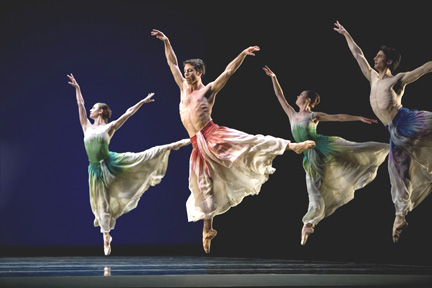 Wonderful in “Pacific’s” return was seeing the imperial Muriel Maffre simply as one in a group of women dancers. Airy port de bras, precisely calibrated turns and deep seated strides, coupled with a miraculous focus at the tasks at hand, Maffre has them in such abundance. It will be difficult to let her go at the end of this season.
Wonderful in “Pacific’s” return was seeing the imperial Muriel Maffre simply as one in a group of women dancers. Airy port de bras, precisely calibrated turns and deep seated strides, coupled with a miraculous focus at the tasks at hand, Maffre has them in such abundance. It will be difficult to let her go at the end of this season.
Set on a modest nine dancers, “Pacific’s” churning rushes suggest an almost visceral sense of space that the dancers can float or plow through and scoop into their arms. And Morris found it all in the music. The opening violin suggested to him head-bobbing vertical hops for a male trio (Ruben Martin, Steven Norman and the handsomely dancing James Sofranko). Robust multi-directional walking and stretching by a female quartet (Maffre with corps members Brooke More, Maureen Choi and Courtney Elizabeth) was brought on by the piano. And finally the cello blew in the main couple — if such a thing exists in Morris — Nicolas Blanc and Tina LeBlanc — and a series of wondrously soft lifts and leaps. From then on “Pacific’s” relative geometry splattered and refocused into ever-surprising combinations, ever delightful to behold.
 Upon second hearing Jenkins score for “The Fifth Season” has not improved; yet the ballet that Tomasson dug out of that material stands up surprisingly well. Structured around a series of pas de deux the most striking of which were the two for Lorena Feijoo and Davit Karapetyan--sultry, dramatic with an underlying sense of hostility. It looks like Feijoo has finally found a partner that can respond in kind to that aspect of her dancing personality. The assurance with which he sent her soaring in the finale made one look forward to future relationships.
Upon second hearing Jenkins score for “The Fifth Season” has not improved; yet the ballet that Tomasson dug out of that material stands up surprisingly well. Structured around a series of pas de deux the most striking of which were the two for Lorena Feijoo and Davit Karapetyan--sultry, dramatic with an underlying sense of hostility. It looks like Feijoo has finally found a partner that can respond in kind to that aspect of her dancing personality. The assurance with which he sent her soaring in the finale made one look forward to future relationships.
Helimets took over partnering Tan from Damian Smith. It’s the kind of role in which he is splendid —generous, in control and tenderly focused on the woman in his arms. In the ‘Waltz’, a double duet, their refined relationship offered a subtle but telling contrast to the sultrier one between the sumptuously pliant Van Patten and Vilanoba. In the ‘Tango’ Van Patten’s trying out men — Helimets, Karapetyan and Vilanoba—was even more imperiously disdainful than last year. “Fifth” is mysterious and intriguing — despite the music.
Photos, all by Eric Tomasson, from top:
Muriel Maffre and Gonzalo Garcia in McGregor's "Eden/Eden."
Vanessa Zahorian in Taylor's "Spring Rounds."
Hansuke Yamamoto in Tomasson's "Chi-Lin."
Vanessa Zahorian and Garrett Anderson in Robbins' "Fancy Free."
Sarah Van Patten and Pierre-François Vilanoba in Wheeldon's "Carousel."
San Francisco Ballet in Morris' "Pacific."
Yuan Yuan Tan and Tiit Helimets in Tomasson's "The Fifth Season."
Volume 5, No. 11
March 19, 2007
copyright ©2007 by Rita Felciano
www.danceviewtimes.com